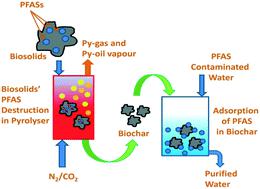当前位置:
X-MOL 学术
›
Environ. Sci.: Water Res. Technol.
›
论文详情
Our official English website, www.x-mol.net, welcomes your feedback! (Note: you will need to create a separate account there.)
Removal of PFASs from biosolids using a semi-pilot scale pyrolysis reactor and the application of biosolids derived biochar for the removal of PFASs from contaminated water
Environmental Science: Water Research & Technology ( IF 5 ) Pub Date : 2020-12-16 , DOI: 10.1039/d0ew00763c Sazal Kundu 1, 2, 3, 4, 5 , Savankumar Patel 1, 2, 3, 4, 5 , Pobitra Halder 1, 2, 3, 4, 5 , Tejas Patel 1, 2, 3, 4, 5 , Mojtaba Hedayati Marzbali 1, 2, 3, 4, 5 , Biplob Kumar Pramanik 2, 3, 4, 5, 6 , Jorge Paz-Ferreiro 1, 2, 3, 4, 5 , Cícero Célio de Figueiredo 7, 8, 9, 10 , David Bergmann 5, 11, 12 , Aravind Surapaneni 3, 5, 11, 12, 13 , Mallavarapu Megharaj 5, 14, 15, 16, 17 , Kalpit Shah 1, 2, 3, 4, 5
Environmental Science: Water Research & Technology ( IF 5 ) Pub Date : 2020-12-16 , DOI: 10.1039/d0ew00763c Sazal Kundu 1, 2, 3, 4, 5 , Savankumar Patel 1, 2, 3, 4, 5 , Pobitra Halder 1, 2, 3, 4, 5 , Tejas Patel 1, 2, 3, 4, 5 , Mojtaba Hedayati Marzbali 1, 2, 3, 4, 5 , Biplob Kumar Pramanik 2, 3, 4, 5, 6 , Jorge Paz-Ferreiro 1, 2, 3, 4, 5 , Cícero Célio de Figueiredo 7, 8, 9, 10 , David Bergmann 5, 11, 12 , Aravind Surapaneni 3, 5, 11, 12, 13 , Mallavarapu Megharaj 5, 14, 15, 16, 17 , Kalpit Shah 1, 2, 3, 4, 5
Affiliation

|
This study focuses on the conversion of biosolids to biochar and its further use in adsorbing per- and polyfluoroalkyl substances (PFASs) from contaminated water. In particular, this study aims to (a) investigate the performance of a semi-pilot fluidised bed pyrolysis unit in converting biosolids into biochar, (b) examine the ability of the pyrolysis–combustion integrated process to destruct PFASs present in biosolids and (c) study the application of biosolids derived biochar for removing PFASs from contaminated water. The semi-pilot fluidised bed pyrolysis unit demonstrated stable temperature and oxygen profiles in the reactor. The yield of biochar was found to be 36–45% at studied temperatures (500–600 °C). The produced biosolids derived biochar samples, due to their lower H/C and O/C ratio, were found to be extremely stable with an expected long (millennia) residence time in soil. It was concluded that >90% removal of perfluorooctanesulfonate (PFOS) and perfluorooctanoic acid (PFOA) from biosolids derived biochar could be achieved in the pyrolysis–combustion integrated process. The biosolids derived biochar demonstrated >80% adsorption of long-chain PFASs and 19–27% adsorption of short-chain PFASs from PFAS contaminated water.
中文翻译:

使用半中试规模的热解反应器从生物固体中去除全氟辛烷磺酸,并将生物固体衍生的生物炭应用于从污水中去除全氟辛烷磺酸
这项研究的重点是将生物固体转化为生物碳,并将其进一步用于从污水中吸附全氟和多氟烷基物质(PFAS)。特别地,本研究旨在(a)研究半先导流化床热解装置将生物固体转化为生物碳的性能;(b)研究热解-燃烧综合过程破坏生物固体中PFAS的能力;和(c )研究生物固体衍生生物炭在去除污水中PFAS方面的应用。半先导流化床热解装置在反应器中显示出稳定的温度和氧气分布。在研究温度(500–600°C)下,生物炭的产率为36–45%。由于其较低的H / C和O / C比,因此生成的生物固体衍生的生物炭样品,被发现是非常稳定的,在土壤中的预期停留时间很长(千年)。结论是,在热解-燃烧综合过程中,可以从生物固体衍生的生物炭中去除全氟辛烷磺酸(PFOS)和全氟辛酸(PFOA)的> 90%。从生物固体中提取的生物炭表明,从PFAS受污染的水中,长链PFAS的吸附> 80%,短链PFAS的吸附率为19–27%。
更新日期:2021-02-18
中文翻译:

使用半中试规模的热解反应器从生物固体中去除全氟辛烷磺酸,并将生物固体衍生的生物炭应用于从污水中去除全氟辛烷磺酸
这项研究的重点是将生物固体转化为生物碳,并将其进一步用于从污水中吸附全氟和多氟烷基物质(PFAS)。特别地,本研究旨在(a)研究半先导流化床热解装置将生物固体转化为生物碳的性能;(b)研究热解-燃烧综合过程破坏生物固体中PFAS的能力;和(c )研究生物固体衍生生物炭在去除污水中PFAS方面的应用。半先导流化床热解装置在反应器中显示出稳定的温度和氧气分布。在研究温度(500–600°C)下,生物炭的产率为36–45%。由于其较低的H / C和O / C比,因此生成的生物固体衍生的生物炭样品,被发现是非常稳定的,在土壤中的预期停留时间很长(千年)。结论是,在热解-燃烧综合过程中,可以从生物固体衍生的生物炭中去除全氟辛烷磺酸(PFOS)和全氟辛酸(PFOA)的> 90%。从生物固体中提取的生物炭表明,从PFAS受污染的水中,长链PFAS的吸附> 80%,短链PFAS的吸附率为19–27%。



























 京公网安备 11010802027423号
京公网安备 11010802027423号